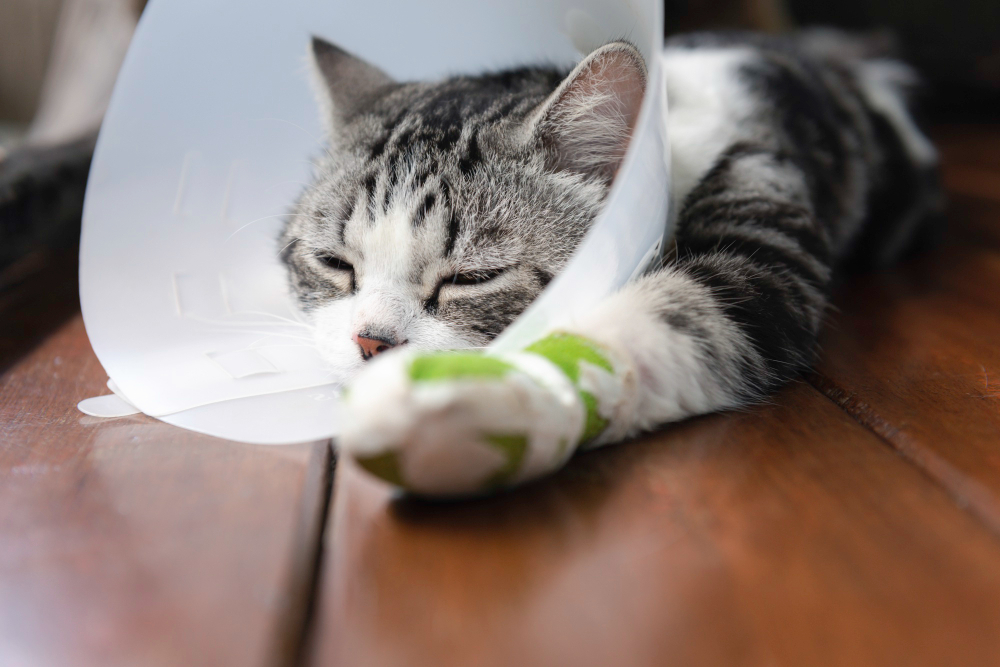You and the kitten will both be affected by a broken leg. However, you may take care of your kitten and the fractured limb by administering first aid, obtaining immediate veterinarian care, and consoling your kitten.
- Recognize the warning signs of a broken limb. Before delivering any first aid, you should look for indicators of a fractured limb. This can assist you in determining whether your cat needs to be sent to the vet or if there is a more severe issue.
- Gently check on your cat. There is a likelihood that your kitten could lash out at you because of the wound. Please avoid scratching or biting your kitten’s leg while you examine it.
- Consult your veterinarian or an after-hours veterinary facility for help with your pet. Immediately after checking your kitten’s leg, contact your veterinarian. Tell the receptionist that your kitten could have a broken limb and that you must make an appointment immediately.
- Bring your kitten to urgent care if your veterinarian is unavailable. To ensure that the veterinarian is prepared for your arrival, call ahead to let them know you’re coming.
- It’s best to keep the kitten’s leg steady. Stabilize the kitten’s leg with a splint or bandage before taking it to the clinic. Injuries and suffering can be lessened in this way. If your kitten permits it, only stabilize the leg.
- Take your kitten to the veterinarian as soon as possible. To properly treat a kitten with a broken limb, only a veterinarian should be consulted. When the leg has been stabilized, and you’ve told the vet that you’ll be there, bring your kitten to the clinic for medical care.
What Can You Do for A Cat with a Broken Leg?
Your kitten will need immediate medical attention if its limb is broken. The only method to verify a broken limb is through veterinary care. As a result, it ensures that your cat receives correct treatment for its leg injury.
- A veterinarian will examine your kitten. In some cases, additional testing like X-rays may be necessary. Exams and testing aid the veterinarian in determining the exact location of the fracture and the most effective course of treatment.
- Make sure your kitten isn’t afraid of the vet touching or pressing on their leg to see whether it feels sore, hot, or out of place. The veterinarian may also put your kitten on the ground to observe its movement. You may also have an MRI, ultrasound, or x-ray was done on your cat to see if there is any internal damage.
- Observe your veterinarian’s treatment plan and follow it to the letter. Your veterinarian will recommend a course of therapy for your cat’s fractured limb. Treatment options will be determined by the fracture’s severity and your kitten’s general health.
- If your kitten has only a single broken bone in its leg, a cast and splint may be necessary to keep it immobilized. Most immobilization treatments take between four and six weeks to recuperate.
- For up to 10 days, drape your kitten’s leg around it if your veterinarian recommends it. Using something can keep your cat from moving or walking about. Keep any casts or crutches in place until a doctor or a therapist removes them.
- Consider the possibility of a surgical procedure. Your veterinarian may recommend surgery if your kitten’s fracture is severe. Doing so will assist your cat’s bone joints and surrounding tissues recover appropriately. In addition, amputation may be indicated if the break is severe.
- Stabilizing the leg may be done by employing pins, cables, and screws. An amputation is also an option. Be sure to follow the veterinarian’s post-operative recommendations.
Can A Kittens Broken Leg Heal on Its Own?
As a result of their rapid growth, young cats’ bones have a perfect blood supply, which allows them to heal for as few as ten days on rare occasions. However, even if the fracture has healed by the time you bring your cat home, they will almost always need roughly two months of therapy and care after the injury.
Advances in animal orthopedic surgery are now on par with those accessible to human patients in terms of technology and the use of materials that are no less costly. Unfortunately, as a result, the most satisfactory treatment option is sometimes also the most expensive. This is regrettable.
As soon as the bone is broken, it will be inflamed, and this discomfort will last for several days at least. When a bone fractures, blood leaks into the surrounding tissue, causing inflammation and blood clotting at the fracture site.
A fracture’s final stage of healing is a process known as bone formation, which can take several months to complete. While remodeling, the bone grows and compacts, eventually returning to its original shape.
In most circumstances, healing from a fractured bone takes six to eight weeks, although this is not a hard and fast rule. Your involvement at this stage is crucial to treating your cat, which will be effective.
This means that you should never feed your cat a diet entirely consisting of meat because it is weak in calcium, which can lead to bone disease. Calcium deficiency is prevalent in kittens, whose bodies require most elements during this development period.
It is particularly fragile since the whole bone is brittle, and the anchoring for any apparatus that helps to stabilize the patient relies on these bones being able to hold the pressure of the device. This makes fractures caused by such a condition extremely delicate. So do not hesitate to speak to one of the veterinarians and vet nurses if you have any questions about your pet’s diet.
Do Kittens Heal Quickly?
- If the injury isn’t too severe, it can recover in as little as two weeks, but it’s best to limit your kitten’s activity until he no longer limps. Consult your veterinarian if the damage does not improve after a few days.
- A splint, tourniquets, or even surgery may be necessary to treat severe tendon or ligament injuries. However, in most situations, the most effective treatment is just rest.
- You may also use ice packs to reduce swelling and inflammation depending on the location of the injury and how well your cat tolerates it. Without an ice pack, a pack of frozen veggies can suffice.
- For 10 to 20 minutes, apply the ice pack to the damaged region and wrap it in a towel. Consult your veterinarian if you’re unsure whether to apply ice to the injury or how often.
- Stay away from leaping and running until the injury is completely healed. A crate may be the only option for keeping a kitten from getting too hyperactive.
- Kittens don’t recognize their physical limits yet; thus, they may attempt to jump from heights they aren’t yet capable of reaching. In addition, ankle sprains muscles can result from various mishaps, including slips and falls, car accidents, and animal assaults.
- Because of the changes in their bodies, kittens are particularly prone to injury. Bruises, sprains, and strains to the tendons, muscles, and ligaments surrounding the bones are all soft tissue injuries.
- It’s best to limit your kitten’s buddies to older children, grownups, and dogs known for their caring nature. Rest and ice will usually help sprains, strains, and torn muscles recover on their own, but if your cat is in significant discomfort or the injury persists for more than a week, you should consult a veterinarian.
How Can I Comfort My Cat in Pain?
Cats, like humans, may get sick and sometimes require medical attention. But unfortunately, even though cats can be treated with medication, it’s never as simple as that because cats can’t communicate with us to tell us what’s wrong.
Since well-meaning specialists assumed that cats wouldn’t experience pain the same way humans do, this was a common misconception among the public. However, when a cat is in pain, we better understand how to treat it since our neural systems are so similar.
If you notice any behavioral or nutritional changes, as well as physical discomfort while moving or being touched, these are all signs that something is wrong with your cat. Bringing your injured cat to the nearest vet is an excellent place to start your task.
Staying hydrated is an effective defense against many ailments, so encourage your cat to stay hydrated. If your cat has difficulty drinking from a bowl, try using a medicine dropper.
Injuries, diseases, and people have unique ways of feeling pain, and pain is no exception. Cats are notoriously difficult to tell apart from other animals when they’re in agony.
You should be aware that arthritic pain in elderly cats is frequent and can express itself in various ways, depending on the part of the body afflicted. Still, a pet owner can’t determine the source with professional guidance. Therefore, preparation is critical to accurately reporting changes in your cat’s behavior to your veterinarian.
Buprenorphine, codeine, fentanyl, hydromorphone, and morphine are all in this class of painkillers. In addition, analgesics such as opioids are used for the treatment of severe surgical pain and the control of severe arthritis pain and advanced cancer pain.














